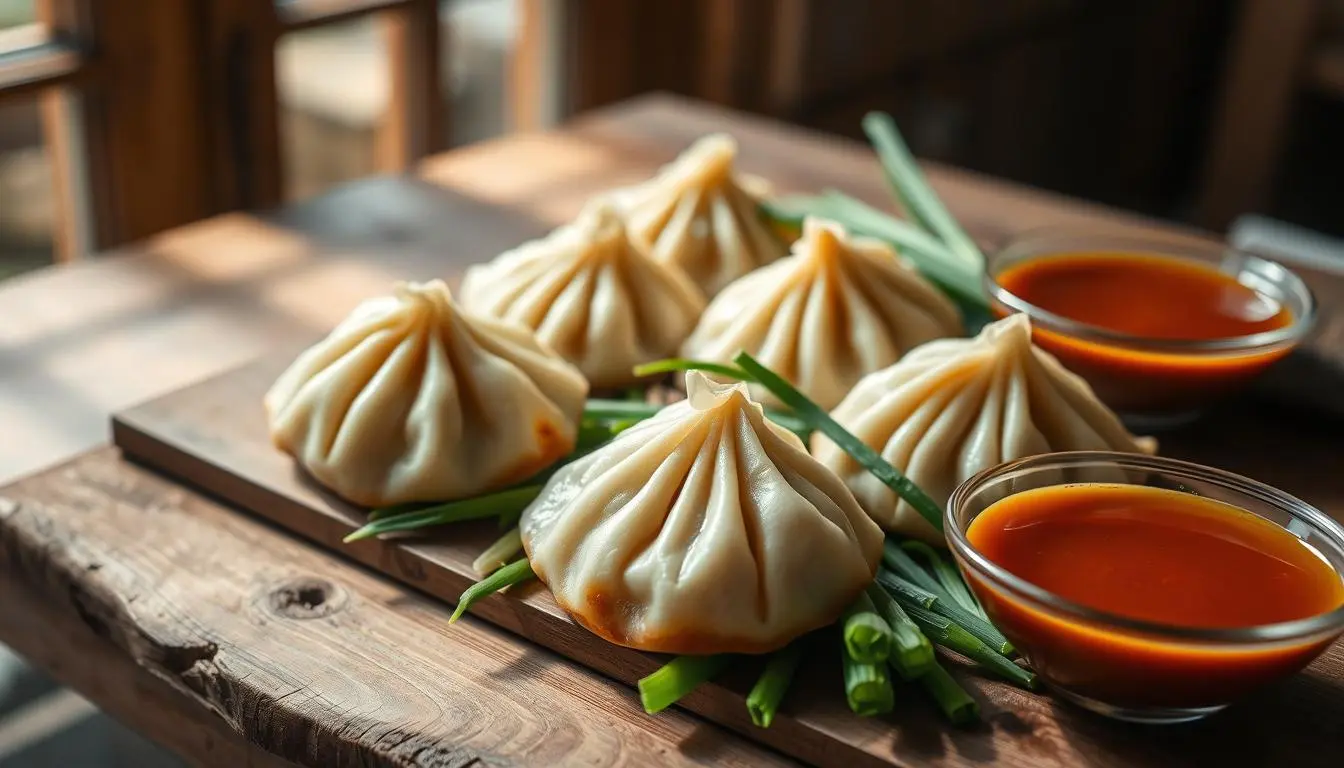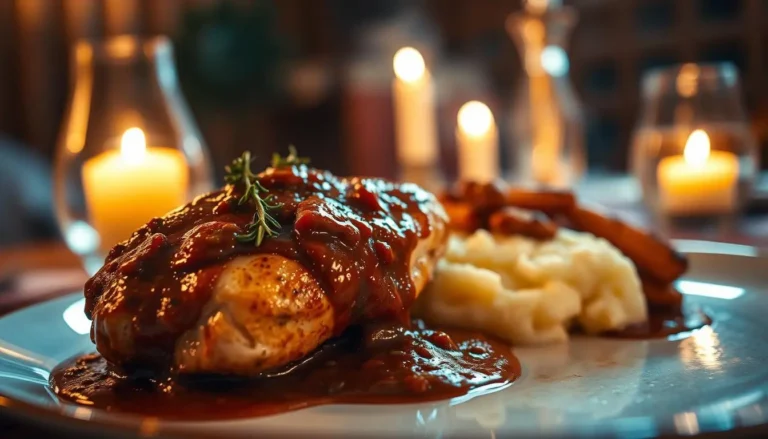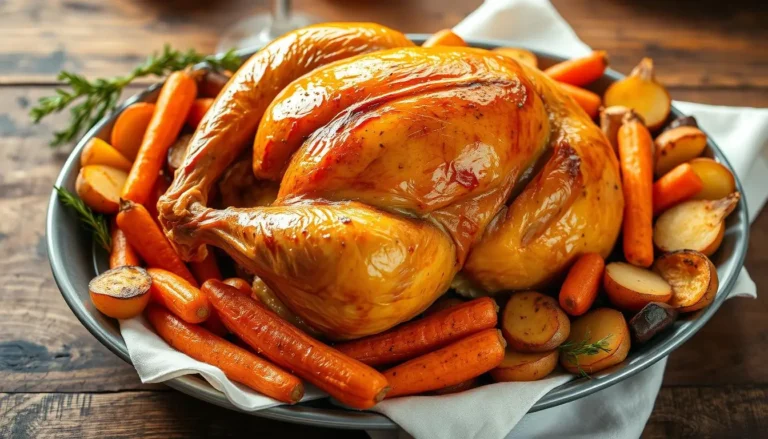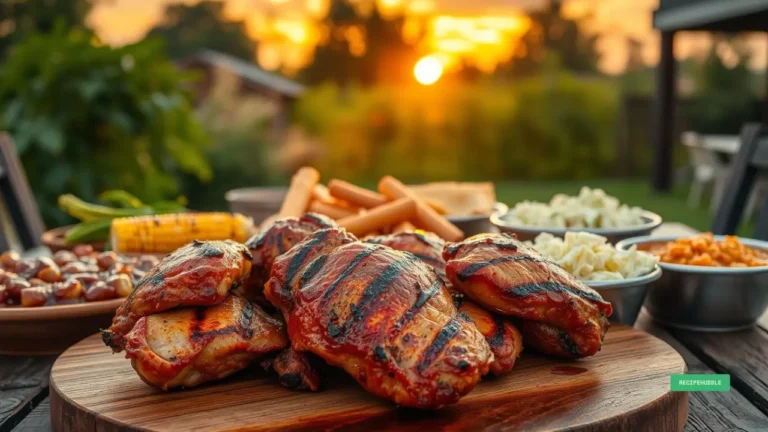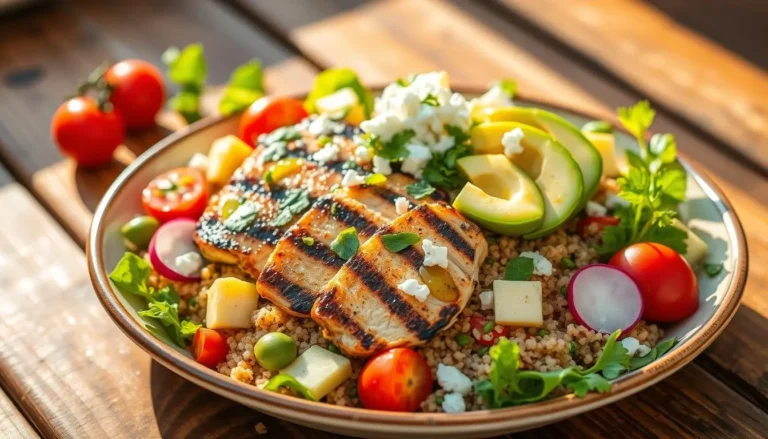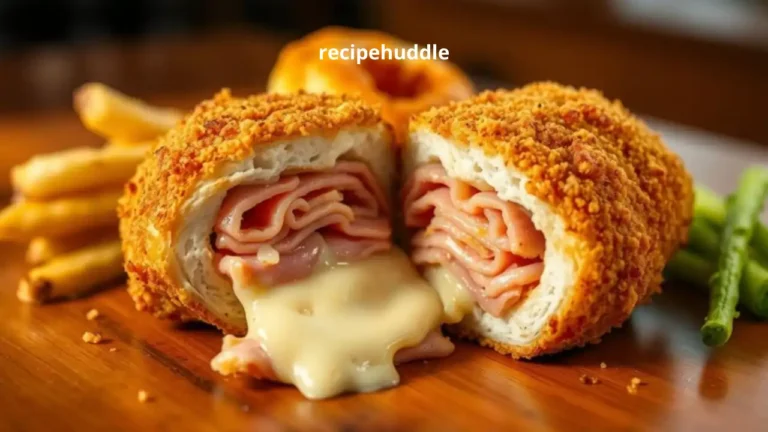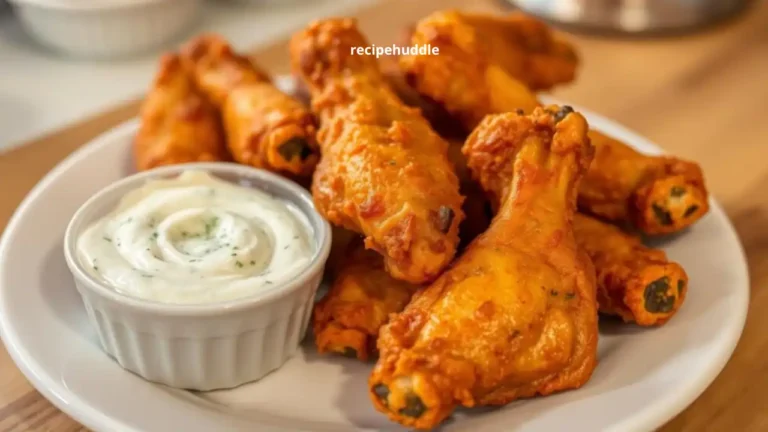Homemade Chicken Potstickers: Easy Recipe & Tips
There’s nothing like the sizzle of a pan-fried dumpling, The mix of crisp and soft textures is amazing, And that first bite of savory filling bursting through a perfectly sealed wrapper is unforgettable.
If you’ve ever dreamed of making that takeout magic at home, this guide is for you, It shows how to make restaurant-quality chicken potstickers with ingredients from your grocery store, These homemade potstickers are more than a recipe. They’re a gateway to weeknight comfort food that impresses friends and family alike.
Table of Contents
What Are Chicken Potstickers? A Brief Introduction
Chicken potstickers, or guo tie, are a classic Chinese dish, They are dough pockets filled with seasoned meats and veggies, The fry-steam-fry technique makes them crispy on the bottom and soft inside.
Let’s explore their origins and what makes them special compared to other Chinese dumplings.
The History Behind Traditional Chinese Dumplings
Chinese dumplings have been around for over 1,800 years, They started as simple filled dough, But over time, different regions developed their own versions.
Pan-fried dumplings like potstickers became popular during the Qing dynasty, Chefs then perfected the sear-steam technique that makes them unique today.
Why Potstickers Got Their Name
The name “potstickers” comes from how they’re cooked, The dough sticks to the pan, creating a golden crust, In Chinese, they’re called guo tie, meaning “stuck-to-the-pan” dumplings.
This accidental trait became their defining feature.
Difference Between Potstickers and Other Dumplings
| Feature | Potstickers | Gyoza | Wontons |
|---|---|---|---|
| Origin | China | Japan | China |
| Cooking Method | Pan-fry + steam | Deep-fried or baked | Boiled or fried |
| Appearance | Crescent shape with pleated edges | Half-moon folded | Square or round wrappers |
Potstickers are special because of their dual cooking process and crescent shape, Unlike gyoza or wontons, their crispy bottom sets them apart.
Essential Ingredients for Authentic Chicken Potstickers
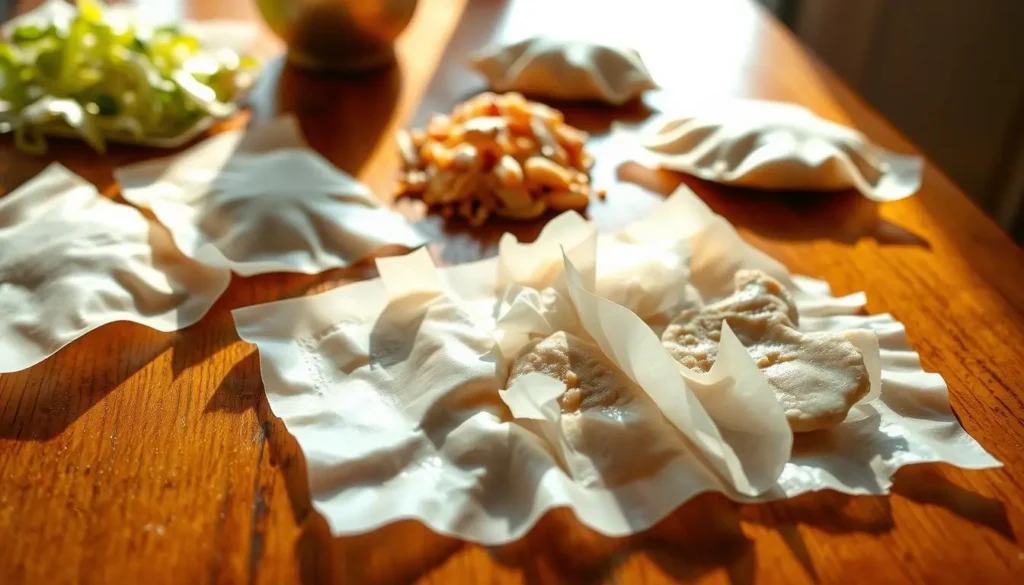

Creating the perfect potsticker filling requires top-notch ingredients, Start with ground chicken, aiming for an 85/15 lean-to-fat ratio for juiciness, If you prefer, ground pork can be used for a different twist.
Napa cabbage adds a nice crunch and keeps the filling moist, Finely shred it to avoid sogginess, Carrots, ginger, and garlic bring a rich, earthy flavor, Use 1 tablespoon of sesame oil for a nutty taste and 2 tablespoons of soy sauce for depth.
For the wrappers, choose round dumpling skins that are both pliable and strong, Add 1/2 teaspoon of sea salt and 1/4 teaspoon of black pepper for extra savory flavor, Remember, each potsticker should hold about 1½ tablespoons of filling to avoid leakage. To prep, briefly parboil the cabbage to remove excess water before mixing.
- Ground chicken (or pork for pork potstickers): 1 lb
- Napa cabbage: 3 cups shredded
- Carrots: 1 medium, finely diced
- Green onions: 3 stalks, chopped
- Ginger: 1/4 tsp freshly grated
- Sesame oil: 1 tbsp
- Soy sauce: 2 tbsp
- Dumpling wrappers: 20 pieces
For storing, freeze uncooked potstickers on a parchment-lined tray before putting them in airtight containers, This prevents them from sticking together, If you’re substituting, ground turkey at an 80/20 ratio is a leaner choice, Each serving of 20 pieces has 502 calories and 32g of protein, Be sure to check labels for non-GMO soy sauce and gluten-free wrappers if necessary.
Preparing the Perfect Potsticker Filling
Every great potsticker starts with a balanced filling, This guide will show you how to make a mix that stays together when folded, It also cooks up juicy and delicious.
Ground Chicken: Choose 85/15 lean-to-fat ground chicken for moisture, Stay away from extra-lean cuts to keep it juicy. For veggie potstickers, use finely chopped shiitake mushrooms for a meaty feel.
- Vegetables: Use a 50/50 protein-vegetable ratio, Shred Napa cabbage finely, then salt it and wring out excess moisture, Pair with carrots, scallions, and minced garlic/ginger.
- Seasonings: Combine 1 tsp soy sauce, ½ tsp oyster sauce, 1 tsp sesame oil, and a pinch of Sichuan pepper, Cook aromatics like ginger and garlic briefly to activate flavors before mixing.
Mix gently: Fold ingredients until just combined to avoid toughness, Overmixing triggers gluten formation, making the filling dense, For veggie potstickers, boost umami with extra mushrooms and soy sauce.
“The key to juicy dumplings? Stop mixing once ingredients are blended—don’t overwork!”
Prep tips: Pre-cook vegetables lightly to release juices, Adjust seasoning with a small test ball before final mixing, Store unused filling refrigerated up to 2 days or freeze in 1-cup portions for later use.
Mastering Potsticker Wrappers: Store-Bought vs. Homemade
Choosing the right wrapper is key for your chicken potstickers, Whether you go for homemade potstickers or store-bought, the wrapper’s texture is crucial, It affects the final crunch and how well they hold together, Let’s look at both options:
How to Make Potsticker Dough From Scratch
To make homemade dough, mix ¾ cup all-purpose flour with ¾ cup bread flour and water, Knead until it’s smooth, then let it rest for 30 minutes, Roll it into 2.5-inch rounds to get 30 wrappers for 1 pound of chicken filling, This whole process takes about 1 hour, but it’s worth it for a fresh, authentic taste.
- Flour mix: ¾ cup all-purpose + ¾ cup bread flour
- Rest dough 30 minutes before rolling
- Roll thin but sturdy to avoid tears
Selecting Quality Pre-Made Wrappers
Choose thicker wrappers like Nissei or Emperor’s Kitchen brands, Thin wonton skins are too fragile for pan-frying, Look for “potsticker” or “gyoza” labeled wrappers in Asian markets or big grocery stores.
Proper Wrapper Handling and Storage
To keep wrappers moist, store unopened packages in a cool pantry, For homemade, freeze extra dough in airtight containers, To separate stuck store-bought wrappers, gently peel them apart using parchment paper.
- Wrap unused wrappers in damp paper towels
- Freeze in labeled bags for up to 2 months
- Thaw frozen wrappers at room temperature
Step-by-Step Folding Techniques for Beautiful Dumplings
Learning to fold potstickers is all about mastering the basics, These steps transform simple ingredients into beautiful chinese dumplings, Start by placing 1–2 teaspoons of filling in the center of a wrapper.
- Moisten the wrapper’s edge with water using your finger.
- Bring opposite edges together, pinching the center first.
- Press the sides inward to form a half-moon shape, sealing edges firmly.
Pleating for Visual Appeal:
- Two-Pleat Technique: After sealing the center, create one pleat on each side for a classic look.
- Four-Pleat Technique: Advanced users can add two pleats per side for intricate patterns.
- One-Directional Pleat: Fold all pleats toward you or away from you for symmetry.
Pro Tips for Success:
Beginners should start with 2 pleats to avoid overcomplicating the process, Use less filling than you think—overstuffing causes leaks, If wrappers are store-bought (stiffer than homemade), press edges firmly to ensure seals, For a professional touch, practice folding 3–4 dumplings before adjusting filling amounts.
Remember, even simple half-moon folds yield delicious results, Focus on sealing edges tightly to prevent cooking leaks, Once folded, transfer dumplings to a floured tray and cover with a cloth while preparing the rest.
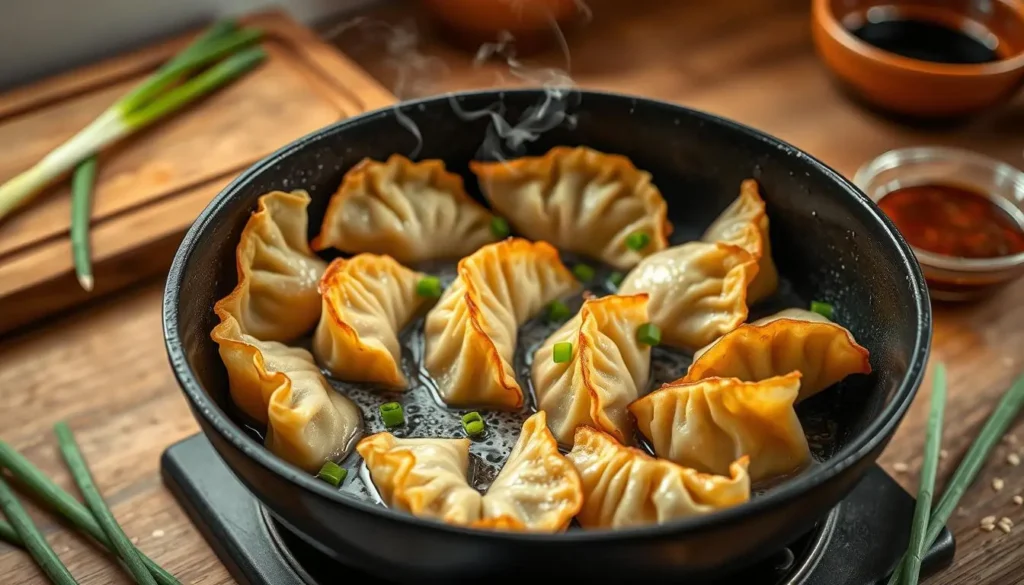

Cooking Methods for Crispy-Bottomed, Tender-Topped Potstickers
Learn to make crispy potstickers with these expert tips, Choose from pan-fry-steam or steam-only methods, Each bite will be both crunchy and tender.
The Traditional Pan-Fry and Steam Method
For pan-fried dumplings with a crunchy bottom, follow these steps:
- Heat 1 tbsp neutral oil in a skillet over medium-high until shimmering.
- Cook filled wrappers 2-3 minutes until bottoms crisp, Avoid moving them to form golden crusts.
- Add ¼-inch water, cover, and steam 6-8 minutes until tender, The “skirt” texture forms where edges curl from steam.
| Step | Action | Time | Tip |
|---|---|---|---|
| 1 | Pan-fry | 2-3 mins | Use non-stick pan for even browning |
| 2 | Steam | 6-8 mins | Check water level before adding |
Steam-Only Alternative for Lighter Potstickers
For lighter potstickers, skip frying, Simmer in ½ inch broth (chicken or veggie) for 10-12 minutes uncovered, This method is great for those watching their diet while keeping the wrappers soft.
Avoiding Common Cooking Mistakes
- Overcrowding: Leave ½-inch spacing between dumplings
- Water level: Fill to ¼ for fresh, ⅓ for frozen
- Lid mishaps: Don’t lift until steam escapes visibly
- Temperature control: Adjust heat to medium to prevent burning
Perfectly cooked potstickers will have translucent wrappers and plump centers, Frozen dumplings need 1-2 extra minutes, Serve immediately with sauce.
Delicious Dipping Sauce Recipes to Complement Your Chicken Potstickers
A good dipping sauce can make homemade chicken potstickers taste like they’re from a restaurant, Here’s a classic recipe that brings out the flavors of the filling:
- Classic Soy-Vinegar Sauce: Mix ½ cup low-sodium soy sauce, 1 tsp rice vinegar, ½ tsp sesame oil, 1 tbsp sugar, and 1 tsp minced scallions, Adjust sweetness with honey or heat with red pepper flakes.
- Spicy Twist: Add ½ tsp crushed red pepper or a dash of sriracha to the base recipe for heat.
- Sweet & Tangy: Increase sugar to 2 tbsp and stir in 1 tsp rice wine vinegar for a brighter finish.
| Nutrient | Amount per 2-tbsp serving |
|---|---|
| Calories | 50 kcal |
| Carbohydrates | 8g |
| Protein | 1g |
| Sodium | 2296mg |
| Sugar | 4g |
| Fat | 1g |
Pro tip: Let flavors meld by mixing ingredients 30 minutes before serving, Store unused sauce in a sealed jar for up to 2 weeks. For authenticity, substitute rice vinegar with Zhenjiang vinegar or add sesame seeds for texture.
“The best dipping sauce balances salty, sweet, and umami notes without masking the chicken’s flavor”
Pair with homemade potstickers for a full sensory experience—crispy edges, juicy filling, and a sauce that ties it all together.
Conclusion: Enjoying Your Homemade Potstickers
Your homemade potstickers are ready to shine, Serve 4–6 per person as a starter or main course, Pair them with bok choy, sesame noodles, or a light broth, Add classic dips like chili garlic sauce, Sriracha, or Mae Ploy’s sweet chili glaze for extra flavor.
Freeze uncooked potstickers by layering them between parchment in airtight containers, They’ll stay fresh up to three months. Reheat cooked leftovers in a lightly greased skillet until crispy, Try adding shrimp or extra ginger to make your next batch unique.
These homemade potstickers show that traditional flavors can be made at home easily, With two dozen made in under an hour, they’re great for sharing, Enjoy them solo or as part of a dim sum feast, Each bite shows off your kitchen creativity.
Mastering this dish opens up a world of possibilities, Your next experiment could be new fillings or inventive sauces, The joy of homemade cooking is in these moments of pride and connection, one golden dumpling at a time.
FAQ
Can I use ground beef or turkey instead of chicken for my potstickers?
Yes, you can use ground beef or turkey as alternatives to ground chicken, Each protein will provide a different flavor profile, so feel free to experiment with what you enjoy most.
Are homemade potstickers difficult to make?
Making homemade potstickers might seem intimidating at first, But with the right guidance and practice, they’re quite approachable, Step-by-step instructions will help you craft delicious dumplings with crispy bottoms and tender tops.
What kind of vegetables work best for the potsticker filling?
Essential vegetables like Napa cabbage and carrots are highly recommended for potstickers, You can also experiment with mushrooms or other veggies if you’re making veggie potstickers.
Can I prepare potstickers ahead of time?
Absolutely! You can prepare your potstickers ahead of time and store them in the freezer or refrigerator, Just make sure to follow proper storage methods to prevent sticking and freezer burn.
What is the difference between potstickers and gyoza?
Potstickers and gyoza are quite similar, but potstickers are thicker and more substantial, Gyoza uses thinner wrappers and is often more finely pleated, Both offer delicious options that are great for dipping!
Do I need special equipment to cook potstickers?
You don’t need special equipment; a regular non-stick skillet, a lid, and a spatula will work well, For lighter potstickers, you may prefer a steamer, but it’s not necessary.
How do I ensure my potstickers don’t stick to the pan?
To prevent sticking, ensure your pan is properly preheated, and use enough oil for frying, Additionally, avoid overcrowding the pan, which can lead to sticking.
What types of dipping sauces pair well with potstickers?
Traditional dipping sauces include a soy-vinegar-sesame blend, You can also try sweet-tangy sauces or spicy alternatives with chili oil or sriracha for added flavor.
Are there gluten-free options for potstickers?
Yes, there are gluten-free dumpling wrappers available at most grocery stores, or you can make your own gluten-free wrappers using alternative flours.
How do I know when my potstickers are fully cooked?
You’ll know your potstickers are fully cooked when the bottoms are golden brown and crispy, and the tops are tender and fully steamed, Typically, the filling should reach an internal temperature of 165°F.

